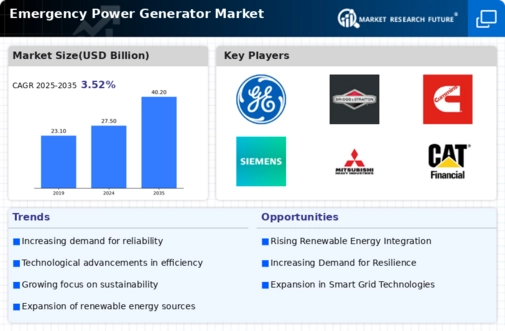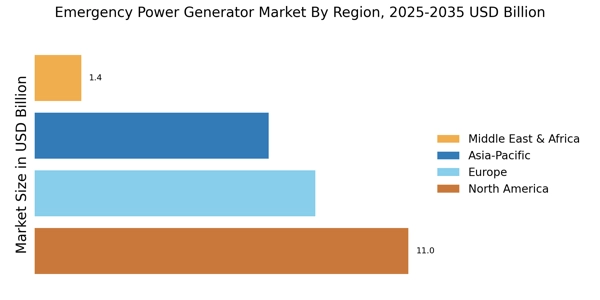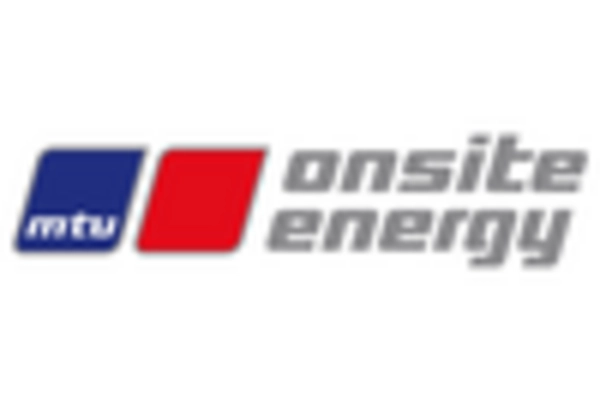Rising Awareness of Energy Security
In the context of the Emergency Power Generator Market, there is a marked increase in awareness regarding energy security among consumers and businesses. This heightened consciousness is largely driven by the unpredictability of energy supply and the potential economic impacts of power disruptions. As organizations recognize the importance of maintaining operational continuity, investments in emergency power generators are becoming a strategic priority. Data indicates that nearly 40% of businesses now consider backup power solutions essential for their operations. This trend is likely to propel the market forward, as companies seek to mitigate risks associated with power failures. Furthermore, the growing emphasis on energy independence is expected to foster innovation in generator technology, leading to more efficient and environmentally friendly solutions.
Government Initiatives and Incentives
Government initiatives and incentives are significantly influencing the Emergency Power Generator Market. Various governments are implementing policies aimed at promoting energy resilience and sustainability, which often include financial incentives for the adoption of backup power solutions. For example, tax credits and rebates for purchasing energy-efficient generators are becoming increasingly common. This support not only encourages consumers to invest in emergency power generators but also stimulates market growth. Recent reports indicate that regions with robust government backing for energy solutions have seen a 25% increase in generator sales. As these initiatives continue to evolve, they are likely to create a favorable environment for both manufacturers and consumers, further propelling the market forward.
Increasing Frequency of Power Outages
The Emergency Power Generator Market is experiencing a notable surge in demand due to the increasing frequency of power outages. Factors such as extreme weather events, aging infrastructure, and rising energy consumption contribute to this trend. According to recent data, power outages have increased by approximately 30% over the past decade, prompting both residential and commercial sectors to seek reliable backup solutions. This growing concern for uninterrupted power supply drives investments in emergency power generators, as businesses and households alike prioritize energy security. The market is projected to expand significantly, with a compound annual growth rate (CAGR) of around 6% anticipated over the next five years. As a result, manufacturers are focusing on developing more efficient and durable generators to meet the evolving needs of consumers.
Technological Innovations in Generator Design
Technological advancements are playing a pivotal role in shaping the Emergency Power Generator Market. Innovations in generator design, such as the integration of smart technology and improved fuel efficiency, are enhancing the appeal of these products. For instance, the introduction of hybrid generators, which combine traditional fuel sources with renewable energy options, is gaining traction among consumers. Market data suggests that the hybrid generator segment is expected to witness a CAGR of over 8% in the coming years. Additionally, advancements in battery storage technology are enabling generators to provide longer-lasting power solutions. As manufacturers continue to invest in research and development, the market is likely to see a proliferation of cutting-edge products that cater to diverse consumer needs, thereby driving overall growth.
Growing Demand from Critical Infrastructure Sectors
The Emergency Power Generator Market is witnessing a surge in demand from critical infrastructure sectors, including healthcare, telecommunications, and data centers. These sectors require uninterrupted power supply to maintain operations and ensure safety. For instance, hospitals rely on emergency generators to support life-saving equipment during outages, while data centers require constant power to protect sensitive information. Market analysis indicates that the healthcare sector alone accounts for approximately 30% of the total generator sales. As the need for reliable power sources intensifies, manufacturers are focusing on developing specialized generators tailored to the unique requirements of these sectors. This trend is expected to drive substantial growth in the market, as investments in critical infrastructure continue to rise.


















Leave a Comment